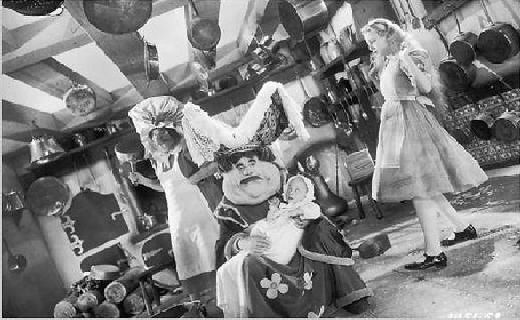Alice in Wonderland (1933) 
“The Entertainment Miracle Of All Times!”

Director: Norman Z. McLeod
Cast: Richard Arlen, Roscoe Ates, William Austin
Synopsis: In Victorian England a bored young girl dreams that she has entered a fantasy world called Wonderland populated by even more fantastic characters.
Fantasy movies like Norman Z. McLeod’s version of Lewis Carroll’s Alice in Wonderland were something of a rarity back in 1933, perhaps because the effects necessary to create a half-way believable world of make-believe were either not yet in existence or were so expensive that only the wealthiest of studios would even contemplate attempting one. It’s surprising, really, given the popularity of escapist movies – particularly musicals – which briefly allowed victims of the depression to forget about their troubles. Nevertheless, this was still the fifth version of Alice’s adventures to have been made in thirty years, and was ironically produced in an all-out attempt by Paramount to stave off bankruptcy. The movie failed at the box office, largely because it was impossible to identify many members of the all-star cast behind their heavy make-up – but the studio stayed afloat thanks to the unexpected success of a couple of Mae West movies.
This 1933 version is, in fact, a blending of both Alice in Wonderland and Alice Through the Looking Glass, which is why Alice enters Wonderland not by following a tardy white rabbit – although the little chap does pop up half way through the movie – but by stepping through the mirror in the sitting room of her sniffy Aunt (Patsy O’Byrne — It Happened One Night, The Canterville Ghost). The first – and perhaps most worrying – thing many will notice about Alice (played here by Charlotte Henry — Murders in the Rue Morgue) is just what a beguiling creature she is. But you can rest easy – Henry was nineteen when the movie was made. She certainly makes a charming companion as we accompany her through what amounts to nothing more than a succession of encounters with characters familiar to those who’ve read the books or watched any of the other 50-odd versions of Alice in Wonderland that have been made to date.
Many of the components of the story Alice is about to experience are cleverly incorporated into the opening scene in which, trapped indoors by the snowy weather, Alice prowls restlessly around the sitting room before settling down for a nap. Her journey through the looking glass takes her into a room that is a reflection of the one she has just departed, complete with figures in a photograph viewed from behind so that they’re looking at the wall instead of gazing out at the room. Eventually, Alice ventures out of the room and into Wonderland proper where she encounters a bewildering array of fantastic creatures.
Each of Alice’s encounters lasts no longer than a minute or two at most, but rather than giving Alice in Wonderland an episodic feel it gives it a pleasingly surreal and dreamlike atmosphere. No semblance of reality is allowed for one moment to intrude upon the bizarre world explored by Alice, with McLeod and co-writer (with Joseph L. Mankiewicz — All About Eve) and uncredited art director William Cameron Menzies (The Beloved Rogue) striving to recreate as closely as possible the drawings of John Tenniel. They make an impressively good job of it as well, staying so true to Tenniel’s vision that they might as well have cast a bunch of nobodies in many of the roles. Cary Grant (Bringing Up Baby, North by Northwest), for example, in the role of the Mock Turtle, is recognisable only by his voice because he wears a false head – which, for some reason looks more like a cow than a turtle. Perhaps most memorable amongst the stars are W. C. Fields (The Dentist, The Pharmacist) in the part of Humpty Dumpty – although because of his make-up rather than Fields’ performance – and Gary Cooper (A Farewell to Arms, Along Came Jones), mocking his prowess as a horseman by repeatedly falling off his mount as the White Knight.
Although the special effects employed by the 1933 version of Alice in Wonderland inevitably look dated these days, they’re still remarkable for their era, and the film remains one of the most faithful to the look of Carroll’s books, even if it plays fast and loose with its chronology.
(Reviewed 18th February 2014)
httpv://www.youtube.com/watch?v=gQgmpEom3KI
